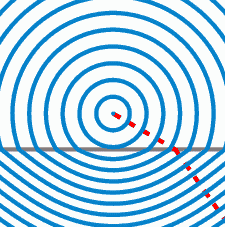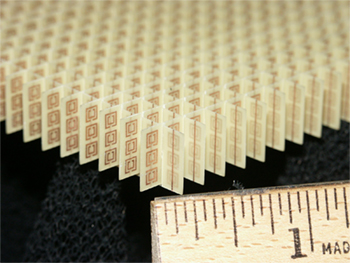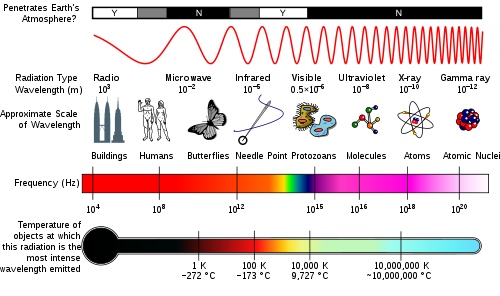Current research and experimentation with metamaterials have led to advancements in the development of invisibility. Metamaterials can be used to make objects appear invisible by bending light around those objects through refraction instead of away from those objects by reflection. Though no natural material exhibits this behavior, engineers are working to design cloaking devices with metamaterials that will refract light around an object and towards the viewer in the same path as if the object were not present. The engineering breakthrough of manipulating the properties of light to create the appearance of invisibility may ultimately have significant future applications.
Introduction
Crazed American fans, from preteens to adults, have read the Harry Potter books, watched the movies, and have undoubtedly been left with the feeling of awe toward the mystical Invisibility Cloak. Though this fabric seems too magical to be real, science is making it possible. As with most scientific discoveries, time will be needed to take the proof of concept to the final goal of cloaking objects so that they are invisible to the human eye. To understand the developing technology of invisibility, a change of perspective is needed. Rather than making an object invisible, everything behind the object can be thought of as visible as though the object were not there to impede the view. Engineers are synthesizing materials that can bend light around whatever object they encompass, creating the illusion that the object is not actually there, thereby making it seem invisible.
How Light Bends
The nature of light has always been a puzzling concept for physicists. Light exhibits the properties of both waves and particles. It travels in straight lines, like an unaccelerated particle; yet, it exhibits diffraction patterns as do water and sound waves. This dichotomy is called the wave-particle duality. It is the wave properties of light that make cloaking possible. When light interacts with an object (a wall, mirror, or even air), it reflects and refracts. Light reflects from a mirror like a ball bouncing off a wall: the incident and reflected rays make equal angles with the normal line (perpendicular line) to the reflecting surface. We can use this understanding to direct light along precise paths. Lasers and holograms make use of this simple law of reflection. It is the more complicated law of refraction, however, that describes the bending of light. Recent advances in the understanding of this rule allow for the prospect of engineered invisibility. Bending light around what is usually blocked by an object, without reflection, would allow the viewer to see what is behind the object instead of the object itself, thus creating the illusion of invisibility (see Fig. 1).
The laws of physics govern the bending of light, and an engineer can only make light go where the laws of physics allow. The rule that governs the path of light rays is Snell’s Law, which says that light travelling through a single material (e.g. air, water, glass) travels in straight lines, and when light travels from one material into another, the rays bends (see Fig. 2). Snell’s Law provides a specific formula for how much light bends in terms of the two media’s indices of refraction, a property specific to each substance.
The index of refraction can be thought of as the slowness of the speed of light in the medium. Its technical definition is the ratio of the speed of light in a vacuum to the speed of light in the medium. The larger the index of refraction, the slower that light travels. Variations in the index of refraction lead to incorrect views of objects. For instance, a mirage is formed when hot air near the ground has a lower index of refraction than cooler air above, causing the light rays coming down from the sky to bend upward as they pass through the hotter air. By the time the light rays reach human eyes, they have bent so much that they are moving up rather than down. Human eyes are not trained to interpret the bending of light, so the image of the sky in the ground is seen instead of the ground itself. These natural variations in index of refraction bend light in a way that makes the sky visible in a place where it is normally not seen. No known natural materials can perform the opposite phenomenon, that is making something invisible where it should be visible. This feat requires a material with a negative index of refraction. The secret behind this phenomenon lies in mathematics.
Mathematics of Invisibility
In 1964, Russian physicist Victor Vesalago pointed out that although no natural materials have a negative index of refraction, the concept of a negative index was consistent with all the fundamental physical laws of electromagnetism [1]. Light is an electromagnetic wave whose wave fronts are electric and magnetic field vectors, both of which, according to Maxwell’s equations, must be perpendicular to the direction in which the wave travels (the light ray).
The way the atomic and molecular structure of a medium affects the propagation of light is captured by two numbers: the electric permittivity (amount of resistance a medium supplies when forming electric field) and the magnetic permeability (how well a material can support the forming of a magnetic field). The index of refraction is the square root of the product of those two numbers. Before Vesalago, scholars assumed that this meant only the positive square root. Maxwell’s equations show that the positive square root is the correct choice, if the electric permittivity and magnetic permeability are both positive. This choice is consistent with the right hand rule, which says that if we use our right hand to rotate the electric field vector into the magnetic field vector, the thumb will point in the direction of the light ray. However, Vesalago hypothesized that if the values of the electric permittivity and magnetic permeability were negative, a left hand rule would apply, and it would be possible to bend light at angles much greater than previous interpretations of Snell’s Law allowed. Moreover, a correctly engineered interface could bend light without any reflections, a phenomenon that was impossible for natural materials. Without any reflections, a cloaked object would appear invisible since no light would bounce off of it. Vesalago did not explicitly mention invisibility in his paper, but the capability of manipulating light in the ways he described made invisibility a consequence. Despite the implicit promise of his theory, invisibility proved impossible to discover or manufacture from a material that exhibited the behavior that Vesalago had predicted. His theory would remain a mathematical curiosity for the next 30 years [2].
Current Research
In 2000, electrical engineers at Duke University confirmed Vesalago’s theory by synthesizing electromagnetic metamaterials (see Fig. 3) with negative indices of refraction and thus jump-starting research in artificial invisibility. David Smith, an electrical engineer at Duke, has been acknowledged as the first man to create a material that could cloak an object from an electromagnetic wave. His device, however, does not cloak an object from visible light, but from microwaves, which have much longer wavelengths (on the scale centimeters) than those of the visible spectrum (on the scale of nanometers). The cloak is an arrangement of loops comprised mostly of plastic encased in tiny copper rings [3]. As described in Scientific American, “a central copper ring – the object to be cloaked – is surrounded by concentric rings of metamaterial standing one centimeter tall and spanning 12 centimeters. The rings are sandwiched between two plates so that microwaves can only travel through the cloak in the plane of the rings” [4]. The dimensions of the loops and rings are smaller than the wavelengths of the waves being cloaked, a property that is characteristic of all metamaterials. In order for the cloak to correctly bend the light wave, the material properties must vary substantially within the distance of a single wavelength. By creating a negative index of refraction, Smith and his colleagues manipulated microwaves to interact with the rings, moving them around the center and refracting back to the other side at the same angle at which they approached the object [5]. Smith explains that, had this been visible light, the deviations from the theoretical predictions would only cause the viewer to see the background with slightly less intensity, while any object in the center would still have been invisible.
In addition to the continued research at Duke, other universities are exploring this new technology. The University of California at Davis has a team of researchers creating a 3-dimensional metamaterial cloak, which will be able to encompass larger objects [6]. Engineers at the University of California at Berkeley have created two new types of metamaterials, both of which utilize circuits that influence the magnetic field of light waves at much higher frequencies [1]. Berkeley researchers report that they have bent red light, with a wavelength of 660 nanometers, around an object. The introduction of these new materials with a broader set of functioning wavelengths helps us to envision the possibilities for this field in the near future. Harry Potter’s cloak may not be much further away.
Challenges
As with any breakthrough, the path to accomplishing such an engineering feat is not an easy one. Success will require the manufacturing of materials with precise structures on the scale of nanometers. The metamaterials constructed at UC Berkeley were the first that could manipulate visible light, which was more difficult than manipulating microwaves (radar waves) or radio waves that previous researchers had done since the wavelength of visible light is much smaller. An electromagnetic spectrum can be seen in Fig. 4, listing different types of light from long wavelengths (on the left) to shorter wavelengths (on the right). Although the same principles apply at all wavelengths, current metamaterials are dispersive, meaning that they bend different wavelengths differently; as a result, a cloak that refracts red light may be unable to refract green light. True invisibility will require a single device that can simultaneously bend electromagnetic waves at all the visible wavelengths.
In order to make something invisible to the naked eye, all wavelengths of visible light must be refracted around the object simultaneously. The visible spectrum ranges from 400-790 THz [1], as can be seen again in Fig. 4. As of now, metamaterials only work for a specific wavelength of light, and designing the materials to defer the entire spectrum of frequencies will require new insights.
Future Applications
Though invisibility to the naked eye is an exciting prospect, the ability to cloak objects from other forms of electromagnetic waves, as well as sound waves, has equally important benefits. Military defense is an area in which this engineering accomplishment may prove most useful. Radar is widely used to detect ships, tanks, and other military vehicles. Thus, a clear advantage is presented to anyone able to cloak these objects from their enemies’ radars. In addition, in the case of a disaster in which people are exposed to radiation, metamaterials could act as deflectors to ensure safety.
The cloaking of sound and elastic waves could prove easier than cloaking light and have even more dramatic impacts. The seismic waves caused by earthquakes typically have wavelengths on the order of kilometers, so a cloak could be built from relatively large components and could channel the destruction around buildings, or even entire cities. Completely soundproof rooms could be possible by deflecting sound waves around the walls of the room [7].
The possibilities of this new technology continue to excite the engineering community. Until Vesalago’s research, scientists had erred through their overly restricted interpretation of Snell’s Law. Vesalago’s revolutionary realization that physics does not deny the possibility of negative indices of refraction has allowed scientists to break through old boundaries and explore new perspectives. Young and enthusiastic minds at universities all over the country are finally working to make invisibility possible. So hold your breath, Potter fans, because we are slowly engineering our imagination into reality.







